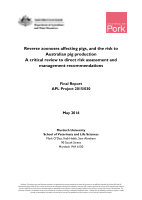Library & Resources
Library & Resources
Complete Research Reports
Item Details

Reverse zoonoses affecting pigs, and the risk to Australian pig production - a critical review to direct risk assessment and management recommendations
93 Pages
Author(s): Mark O'Dea, Ihab Habib, Sam Abraham
This project was commissioned by Australian Pork Limited (APL), to determine the greatest zooanthroponotic (reverse zoonotic or transmitted from humans to pigs) risks to the Australian pork industry, and to allow for development of recommendations based on the findings. The review identified 22 agents with reverse zoonotic potential which could present some risk to the Australian pig production industry.
Taenia solium is the highest ranking parasitic agent, and risk mitigation strategies for introduction of this could include education campaigns, adequate maintenance and positioning of human sewerage systems, and treatment of workers returning from endemic areas.
E. coli, MRSA, Streptococcus suis and Salmonella sp. rank highly amongst the agents. All have similar potential risks to the industry, and require similar education campaigns as discussed to minimise transmission. Details on potential surveillance programmes are outlined in the discussion.
The major pathways for entry of these pathogens into a herd are via farm workers, water supply and feed supply. A key, early measure which could be easily and rapidly adopted by industry would be an education campaign to be distributed on-farm, using the information in this review to outline to workers the risks of transmission of these organisms. Adequate sanitation of incoming water and high level personal hygiene when mixing feeds or working on feeders, are keys to minimising risk of transmission.
Download



